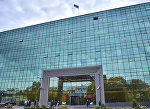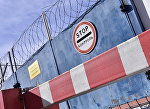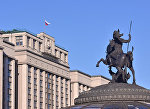Alexander Karpov, RAPSI
During a speech on September 6, 2006, then US President George W. Bush addressed the nation and the families of those killed in the 9/11 terror attacks. He revealed that the US Central Intelligence Agency (CIA) was in fact running a secret counter-terrorism program without going into much details about it, and declared the program closed.
Bush also assured the American people that torture was not used against those suspected of terrorism captured through the CIA program, including the alleged mastermind of the 9/11 attacks Khalid Sheikh Mohammed. He rather described the methods used to extract intel as an “alternative set of procedures”.
Those who, after having been detained during the US war on terror, ended up detained at the infamous US military prison compound in Guantanamo Bay, Cuba (GTMO) have brought the issue of CIA's worldwide network of "black sites" back on the surface by turning to the European Court of Human Rights (ECHR).
CIA secret counter-terrorism program
The claims filed with the Court allege that on September 17, 2001, in the direct aftermath of a series of deadly terror attacks upon the US, “Bush signed a classified Presidential Finding granting the CIA extended competences relating to its covert actions, in particular authority to detain terrorist suspects and to set up secret detention facilities outside the United States, in cooperation with the governments of the countries concerned.” This program came to be known as extraordinary rendition.
According to a set of memos written by Assistant Attorney General Steven G. Bradbury, the CIA had taken 94 prisoners into custody in secret prisons by May 2005. These memos were referenced in the UN Human Rights Council report on secret detention policies published in February 2010.
A report on “counterterrorism detention and interrogation activities” prepared in 2004 by CIA Inspector General John Helgerson, and made public by in 2009, stated that certain “High-Value Detainees” (HVD) were assigned the highest priority for capture, detention and interrogation, because of their possible possession of information related to terror threats.
The heavily redacted report went on to state that such HVDs were subject to “enhanced interrogation techniques” (EITs), including the “waterboard technique,” according to the applicants’ claim.
In 2009, in his speech on national security, now President Barack Obama referred to these measures as “unfortunate,” and referred to them as a somewhat misguided result of sincere desire to protect American people.
Claims before the European Court of Human Rights (ECHR)
The human rights violation claims were filed with the ECHR by Abd Al Rahim Hussayn Muhammad Al Nashiri, a Saudi Arabian national, and Zayn Al-Abidin Muhammad Husayn, also known as Abu Zubaydah, born in Saudi Arabia. More than ten years have passed already since their captures. Al Nashiri (b. 1965) is suspected of having taken part in at least two terrorist attacks, and Mr. Husayn (b. 1971) is considered by the US authorities as one of the key members of the Al Qaeda terror network. Hearings into both applications were held last week.
On Tuesday, December 3, attorneys for Zabudayah and Al Nashiri presented their case that Poland was one of the countries where a secret detention site was allegedly arranged.
A day prior, a hearing behind closed doors was held where numerous experts and witnesses are said to have testified. Both applicants claim to have been victims of “extraordinary renditions” by the CIA, that they were brought to Poland for interrogation, and that they were subjected while in the country to torture with the consent of the Polish authorities. The claims read that the extraction methods included standard measures, without additional physical or substantial psychological pressure. They, among other things included leaving the prisoners naked, isolation, loud music, water dousing and up to 72 hours sleep deprivation. Enhanced measures included physical abuse, prolonged sleep deprivation (over 72 hours); stress positions, cramped confinement and waterboarding.
Both applications cite among their sources a number of reports and investigation sheets, including reports prepared by Swiss Senator Dick Marty in his capacity as rapporteur for the investigation held by the Parliamentary Assembly of the Council of Europe into CIA detention facilities allegations. In June 2007, in a report for the Council of Europe, Marty, for example, stated that he had enough “evidence to state that secret detention facilities run by the CIA did exist in Europe from 2003 to 2005, in particular in Poland and Romania.”
During the hearings at the ECHR, it was claimed that an alleged rendition plane marked with the tag N63MU brought its passengers to a small airfield in Poland. All personnel, according to the claim, were instructed to leave the plane alone, and all those who worked shifts that day, went home with hefty sums in cash. The plane, flying in from Thailand brought in HVDs, to be carried off in unmarked vans for the new special CIA processing facility, where a sturdy steel cage, ordered from a local contractor, was already in place.
Investigation is underway in Poland
Polish authorities have launched investigation into allegations concerning the CIA black sites on its territory in 2008. That’s when the first witness into the case was allegedly questioned. Counsels for Zabudayah and Al Nashiri have told the Court that the major problem is that all the documents on the Polish side are classified and there is no opportunity to get access to them and to find out at least anything. Notably, Mikolaj Pietrzak, Al Nashiri’s counsel, complained that Poland has not provided any update on the status of the investigation. Bartlomiej Jankovswski, Zubaydah’s counsel, in his turn said that he was granted access to bits of information just twice since 2010.
Artur Nowak-Far, Undersecretary of State at the Poland’s Ministry of Foreign Affairs, told the Court in his turn that it’s vital to preserve the confidentiality of the investigation the major goal of which is to establish facts and find those who might bear responsibility for the alleged breaches of law. He reminded that Polish and the US intelligence is involved here. In his words, “the investigation is progressing effectively” and it is as transparent as it might be. He also claimed that the length of this investigation which is still ongoing shouldn’t be misguiding taking into account the complexity of the case and its international aspect. In the end of his speech Nowak-Far assured the Court and the applicants’ counselors that no political pressure has been asserted against the prosecutor who heads the investigation in question.
Janusz Sliwa, Deputy Prosecutor of appeal from Krakow, told the ECHR that Poland, in fact, was the only country that was “conducting a real investigation” into the CIA black sites, and that the inquiry was progressing slowly due to the fact that it was extremely difficult to meet with the applicants held at GTMO.
The investigation has been extended several times and remains pending. Not long ago it was extended being February, 2014. The authorities have not disclosed the exact terms of reference or the precise scope of the investigation.
The blind confidentiality of the investigation became a key issue during the hearings at the ECHR. The applicants’ counsels claimed that it poses an obstacle in the ECHR’s thorough consideration of the claims and blamed the Polish side for the alleged lack of cooperation with the Court. Representatives on the Polish side in their turn said that the data couldn’t be provided to the Court because its rules of procedure do not apply to a sensitive national security case.
In the aftermath
Even the accounts of what happened there are out in the open, the Polish authorities that vowed to investigate the human rights violations seem to be fumbling in the dark. The sough after investigation was started two years after Bush admitted that some “alternative set of procedures” may have been applied to certain people.
Shifting of prosecutors, classification of various documents with unclear explanations and the noticeable lack of charges were highlighted at the ECHR hearings as signs of Poland’s reluctance to get to the bottom of the story.
The Polish authorities refuted the repeated accusations brought on by the counsels of Al Nashiri and Abu Zubaydah of procrastinating the investigation and even obstructing justice. The questions put forth by the counsels and the judges were explained away with needs to protect the investigation from outside pressure and retain its confidentiality.
Not a single word was brought during the open hearing in the ECHR that it is Poland on the stand, while the masterminds of the “extraordinary renditions” was the US. The Polish authorities allegedly hosted the CIA’s operation to extract the information from the HVDs, but the program itself and the logistic planning for it were designed elsewhere.
Former Polish president Aleksander Kwasniewski said an interview in 2012 with leading daily Gazeta Wyborcza: “Of course, everything took place with my knowledge.” “The President and the Prime Minister agreed to secret service co-operation with the Americans, because that is what was required by national interest… the decision to co-operate with the CIA carried a risk that Americans would use unacceptable methods. But if a CIA agent brutally treated a prisoner in a Marriott hotel in Warsaw, would you charge the directors of that hotel for the actions of that agent?”
The question of violations of human rights shifted from a tangible moral dilemma, that was much reflected upon in the recent mass media op-eds to bureaucratic and procedural events in the ECHR, bearing relevance only to legal experts and human rights lawyers.
Poland goes on with the investigation, and the Al Nashiri’s and Abu Zubaydah’s counsels go on fighting the good fight, perhaps losing sight of the fact that the people they represent may be very well responsible for an untold suffering of a greater number of people than that affected by the CIA secrete counter-terrorism program. The claim of a “global criminal conspiracy”, made from the stand by a UN’s own Special Rapporteur on human rights Ben Emerson will remain in the headlines and news morgues and will go on unanswered.
Is there an over-arching conspiracy? That's impossible to tell, but there are many powerful factions with their own agendas. To the extent these agendas overlap they are prepared to collaborate - they're like players at an illegal card table. In the game they play against each other, but they'll stand together to keep the table secret.
Decade or two ago, the sheer notion of a “black site” prison would’ve been deemed as facetious by all but the most stalwart conspiracy theorists. A secret facility, run off the books by CIA, outside the reach of the government and the public, a story like that reads like a discarded X-Files peril of the week plot, or a synopsis for an upcoming Tom Clancy novel.
But the wave broke, and rolled back before the public could grasp how exactly we the people reached this point. The issue of extraordinary rendition shifted from the point of “do we need torture” to the now discussed “who is going to take the fall for it.”
And after that is resolved, the only reaction left to the public that was saved from the harm at the hands of the looming terrorist threat, is reflection and satire. In the recent billion dollar grossing GTA V video game, during one deeply disturbing scene, the psychotic villain-protagonist Trevor Phillips muses that “only the torturer actually needs torture”, after torturing a useless confession from a man who is accused withholding information regarding a potential terrorist attack, fully aware that the man is innocent. He does so, ironically, under the guidance and with the blessing of a corrupt alphabet agent.


